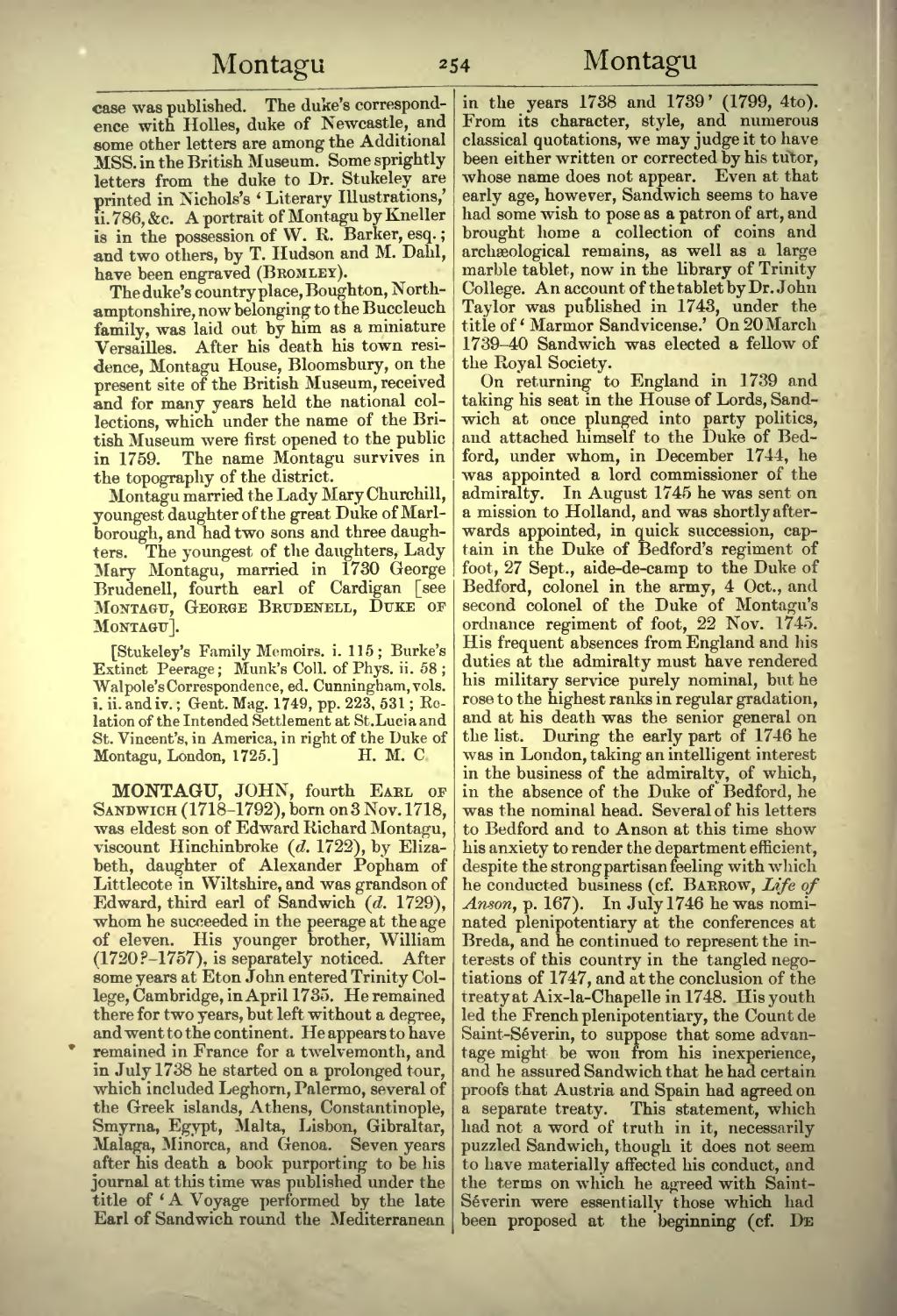case was published. The duke's correspondence with Holles, duke of Newcastle, and some other letters are among the Additional MSS. in the British Museum. Some sprightly letters from the duke to Dr. Stukeley are printed in Nichols's 'Literary Illustrations,' ii. 786, &c. A portrait of Montagu by Kneller is in the possession of W. R. Barker, esq.; and two others, by T. Hudson and M. Dahl, have been engraved (Bromley).
The duke's country place, Boughton, Northamptonshire, now belonging to the Buccleuch family, was laid out by him as a miniature Versailles. After his death his town residence, Montagu House, Bloomsbury, on the present site of the British Museum, received and for many years held the national collections, which under the name of the British Museum were first opened to the public in 1759. The name Montagu survives in the topography of the district.
Montagu married the Lady Mary Churchill, youngest daughter of the great Duke of Marlborough, and had two sons and three daughters. The youngest of the daughters, Lady Mary Montagu, married in 1730 George Brudenell, fourth earl of Cardigan [see Montagu, George Brudenell, Duke of Montagu].
[Stukeley's Family Memoirs, i. 115; Burke's Extinct Peerage; Munk's Coll. of Phys. ii. 58; Walpole's Correspondence, ed. Cunningham, vols. i. ii. and iv.; Gent. Mag. 1749, pp. 223, 531; Relation of the Intended Settlement at St.Lucia and St. Vincent's, in America, in right of the Duke of Montagu, London, 1725.]
MONTAGU, JOHN, fourth Earl of Sandwich (1718–1792), born on 3 Nov. 1718, was eldest son of Edward Richard Montagu, viscount Hinchinbroke (d. 1722), by Elizabeth, daughter of Alexander Popham of Littlecote in Wiltshire, and was grandson of Edward, third earl of Sandwich (d. 1729), whom he succeeded in the peerage at the age of eleven. His younger brother, William (1720?-1757), is separately noticed. After some years at Eton John entered Trinity College, Cambridge, in April 1735. He remained there for two years, but left without a degree, and went to the continent. He appears to have remained in France for a twelvemonth, and in July 1738 he started on a prolonged tour, which included Leghorn, Palermo, several of the Greek islands, Athens, Constantinople, Smyrna, Egypt, Malta, Lisbon, Gibraltar, Malaga, Minorca, and Genoa. Seven years after his death a book purporting to be his journal at this time was published under the title of 'A Voyage performed by the late Earl of Sandwich round the Mediterranean in the years 1738 and 1739' (1799, 4to). From its character, style, and numerous classical quotations, we may judge it to have been either written or corrected by his tutor, whose name does not appear. Even at that early age, however, Sandwich seems to have had some wish to pose as a patron of art, and brought home a collection of coins and archaeological remains, as well as a large marble tablet, now in the library of Trinity College. An account of the tablet by Dr. John Taylor was published in 1743, under the title of 'Marmor Sandvicense.' On 20 March 1739-40 Sandwich was elected a fellow of the Royal Society.
On returning to England in 1739 and taking his seat in the House of Lords, Sandwich at once plunged into party politics, and attached himself to the Duke of Bedford, under whom, in December 1744, he was appointed a lord commissioner of the admiralty. In August 1745 he was sent on a mission to Holland, and was shortly afterwards appointed, in quick succession, captain in the Duke of Bedford's regiment of foot, 27 Sept., aide-de-camp to the Duke of Bedford, colonel in the army, 4 Oct., and second colonel of the Duke of Montagu's ordnance regiment of foot, 22 Nov. 1745. His frequent absences from England and his duties at the admiralty must have rendered his military service purely nominal, but he rose to the highest ranks in regular gradation, and at his death was the senior general on the list. During the early part of 1746 he was in London, taking an intelligent interest in the business of the admiralty, of which, in the absence of the Duke of Bedford, he was the nominal head. Several of his letters to Bedford and to Anson at this time show his anxiety to render the department efficient, despite the strong partisan feeling with which he conducted business (cf. Barrow, Life of Anson, p. 167). In July 1746 he was nominated plenipotentiary at the conferences at Breda, and he continued to represent the interests of this country in the tangled negotiations of 1747, and at the conclusion of the treaty at Aix-la-Chapelle in 1748. His youth led the French plenipotentiary, the Count de Saint-Severin, to suppose that some advantage might be won from his inexperience, and he assured Sandwich that he had certain proofs that Austria and Spain had agreed on a separate treaty. This statement, which had not a word of truth in it, necessarily puzzled Sandwich, though it does not seem to have materially affected his conduct, and the terms on which he agreed with Saint-Severin were essentially those which had been proposed at the beginning (cf. De
